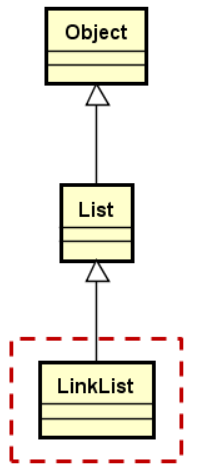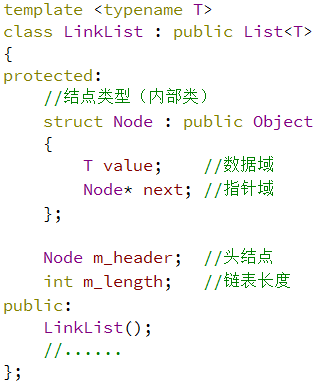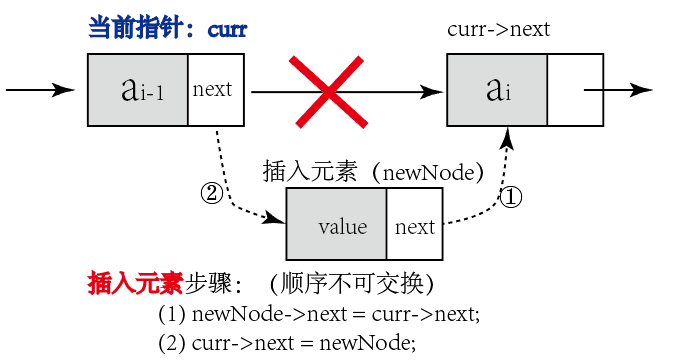第22課 單鏈表的實現
阿新 • • 發佈:2017-05-27
.cn toa nod 越界 bool 遞歸調用 isp {} log 




1. LinkList類的設計要點


(1)用類模板實現,通過頭結點訪問後繼結點
(2)定義內部結點類型Node(註意繼承於自定義的Object頂層父類),用於描述數據域和指針域.
(3)實現線性表的關鍵操作(增、刪、查等)
2. 單鏈表的內部結構

(1)頭結點在單鏈表中的意義:輔助數據元素的定位,方便插入和刪除操作;
(2)頭結點不存儲實際的數據元素
3. 單鏈表的操作
(1)插入元素

①從頭結點開始,通過current指針定位到目標位置(註意:current->next保留著目標元素的地址)
②從堆空間中申請新的Node結點
③執行插入操作
node->value = e; node->next = current->next; current->next = node;
(2)刪除元素

①從頭結點開始,通過current指針定位到目標位置(toDel地址保存在curr->next中)
②使用toDel指針指向需要刪除的結點
③執行刪除操作
toDel = current->next; current->next = toDel->next; delete toDel;
【編程實驗】單鏈表的實現
//Object.h

#ifndef _OBJECT_H_View Code#define _OBJECT_H_ namespace DTLib { class Object { public: //以下四個重載函數用於統一不同編譯器new失敗時的結果不同的問題。 //throw()表示不拋出異常,即如果申請內請失敗時,統一返回NULL而不拋異常 void* operator new(unsigned int size) throw(); void operator delete(void* p); void* operator new[](unsigned int size) throw(); void operator delete[](void* p); virtual ~Object() = 0; }; } #endif // _OBJECT_H_
//Object.cpp

#include "Object.h" #include <cstdlib> using namespace std; namespace DTLib { void * Object::operator new(unsigned int size) throw() { return malloc(size); } void Object::operator delete(void *p) { free(p); } void *Object::operator new[](unsigned int size) throw() { //當用new Test[5]時,只須傳入數組元素的個數,編譯器會向operator new[](...)函數的參數 //傳入5*sizeof(Test) + sizeof(unsigned int),其中的sizeof(unsigned int)為額外 //空間,用於保存元素的個數。 return malloc(size); } void Object::operator delete[](void *p) { free(p); } Object::~Object() { } }View Code
//Exception.h

#ifndef _EXCEPTION_H_ #define _EXCEPTION_H_ #include "Object.h" namespace DTLib { #define THROW_EXCEPTION(e, m) (throw e(m, __FILE__, __LINE__)) class Exception : public Object { protected: char* m_message; char* m_location; void init(const char* message, const char* file, int line); public: //構造函數 Exception(const char* message); Exception(const char* file, int line); Exception(const char *message, const char *file, int line); //拷貝構造函數 Exception(const Exception& e); //重載賦值操作符 Exception& operator=(const Exception& e); virtual const char* message() const; virtual const char* location() const; //註意: //(1)析構函數是較為特殊的函數,一旦定義了析構函數,不管這個函數是不是純虛函數,就 //必須提供實現。因為,對象在銷毀時,最後都會調用父類的析構函數。如果父類不提供實現, //當對象銷毀過程中調用到父類析構函數時,就找不到析構函數,也就不知該如何析構下去。 //因此,盡管這裏將析構函數聲明為純虛函數,但Exception類仍提供析構函數的實現。以便 //最後正確釋放掉m_message和m_location所指的堆空間. //(2)此外,聲明為純虛函數,可以讓該類只能作為接口使用,而且也強迫子類必須 //提供析構函數的實現。 virtual ~Exception() = 0; //純虛函數 }; //計算異常類 class ArithmeticException: public Exception { public: ArithmeticException():Exception(0){} ArithmeticException(const char* message):Exception(message){} ArithmeticException(const char*file, int line):Exception(file, line){} ArithmeticException(const char *message, const char* file, int line):Exception(message, file, line){} ArithmeticException(const ArithmeticException& e): Exception(e){} ArithmeticException& operator=(const ArithmeticException& e) { Exception::operator =(e); return *this; } }; //空指針異常類 class NullPointerException: public Exception { public: NullPointerException():Exception(0){} NullPointerException(const char* message):Exception(message){} NullPointerException(const char*file, int line):Exception(file, line){} NullPointerException(const char *message, const char* file, int line):Exception(message, file, line){} NullPointerException(const NullPointerException& e): Exception(e){} NullPointerException& operator=(const NullPointerException& e) { Exception::operator =(e); return *this; } }; //越界異常類 class IndexOutOfBoundsException: public Exception { public: IndexOutOfBoundsException():Exception(0){} IndexOutOfBoundsException(const char* message):Exception(message){} IndexOutOfBoundsException(const char*file, int line):Exception(file, line){} IndexOutOfBoundsException(const char *message, const char* file, int line):Exception(message, file, line){} IndexOutOfBoundsException(const IndexOutOfBoundsException& e): Exception(e){} IndexOutOfBoundsException& operator=(const IndexOutOfBoundsException& e) { Exception::operator =(e); return *this; } }; //內存不足異常類 class NotEnoughMemoryException: public Exception { public: NotEnoughMemoryException():Exception(0){} NotEnoughMemoryException(const char* message):Exception(message){} NotEnoughMemoryException(const char*file, int line):Exception(file, line){} NotEnoughMemoryException(const char *message, const char* file, int line):Exception(message, file, line){} NotEnoughMemoryException(const NotEnoughMemoryException& e): Exception(e){} NotEnoughMemoryException& operator=(const NotEnoughMemoryException& e) { Exception::operator =(e); return *this; } }; //參數錯誤異常類 class InvalidParameterException: public Exception { public: InvalidParameterException():Exception(0){} InvalidParameterException(const char* message):Exception(message){} InvalidParameterException(const char*file, int line):Exception(file, line){} InvalidParameterException(const char *message, const char* file, int line):Exception(message, file, line){} InvalidParameterException(const InvalidParameterException& e): Exception(e){} InvalidParameterException& operator=(const InvalidParameterException& e) { Exception::operator =(e); return *this; } }; //無效操作異常類(成員函數調用時,如果狀態不正確則拋出異常) class InvalidOperationException: public Exception { public: InvalidOperationException():Exception(0){} InvalidOperationException(const char* message):Exception(message){} InvalidOperationException(const char*file, int line):Exception(file, line){} InvalidOperationException(const char *message, const char* file, int line):Exception(message, file, line){} InvalidOperationException(const InvalidOperationException& e): Exception(e){} InvalidOperationException& operator=(const InvalidOperationException& e) { Exception::operator =(e); return *this; } }; } #endif // _EXCEPTION_H_View Code
//Exception.cpp

#include "Exception.h" #include <cstring> #include <cstdlib> using namespace std; namespace DTLib { void Exception::init(const char *message, const char *file, int line) { m_message = strdup(message); //復制message的內容 m_location = NULL; if(file != NULL){ char sl[16]={0}; itoa(line, sl, 10);//將整數line轉為字符串,其中的10表示轉換為十進制格式 //m_location的格式為:file:line\0; m_location = static_cast<char*>(malloc(strlen(file) + strlen(sl) + 2)); //註意:申請內存失敗時無須再拋NotEnoughMemoryException異常,從宏觀上看,父類 //是無法拋出子類型的異常的。從邏輯上看也不能拋出這個異常,因為當父類構造時出現異常時, //如果去拋出子類異常,則必然需要構造子類,但這又得先調用父類構造函數(會再一次產 //生異常,從而造成Exception構造函數的遞歸調用,從而造成死循環!) if(m_location != NULL){ //內存申請成功 m_location = strcpy(m_location, file); m_location = strcat(m_location, ":"); m_location = strcat(m_location, sl); } } } //構造函數 Exception::Exception(const char* message) { init(message, NULL, 0); } Exception::Exception(const char* file, int line) { init(NULL, file, line); } Exception::Exception(const char *message, const char *file, int line) { init(message, file, line); } //拷貝構造函數 Exception::Exception(const Exception& e) { //深拷貝 m_message = strdup(e.m_message); m_location = strdup(e.m_location); } //重載賦值操作符 Exception& Exception::operator=(const Exception& e) { if(this != &e){ //防止自賦值 free(m_message); free(m_location); //深拷貝 m_message = strdup(e.m_message); m_location = strdup(e.m_location); } return *this; } const char* Exception::message() const { return m_message; } const char* Exception::location() const { return m_location; } Exception::~Exception() { free(m_message); free(m_location); } }View Code
//List.h

#ifndef _LIST_H_ #define _LIST_H_ #include "Object.h" namespace DTLib { template <typename T> class List : public Object { protected: //禁用拷貝構造函數和賦值操作符 //List(const List&); //List& operator=(const List&); public: //由於以上添加了拷貝構造函數,編譯將不再提供 //默認的一些構造函數。這裏需要手工加上無參構造函數 List(){} virtual bool insert(const T& e) = 0;//往線性表尾部插入元素 virtual bool insert(int index, const T& elem) = 0; virtual bool remove(int index) = 0; virtual bool get(int index, T& elem) const = 0; virtual int length() const = 0; virtual void clear() = 0; }; } #endif // _LIST_H_View Code
//LinkList.h
#ifndef _LINKLIST_H_ #define _LINKLIST_H_ #include "list.h" #include "Exception.h" namespace DTLib { template <typename T> class LinkList : public List<T> { protected: //結點類型(內部類) struct Node : public Object { T value; //數據域 Node* next; //指針域s }; //由於m_header在定義時會調用T的構造函數。如果T的設計者在構造函數中拋出異常,當LinkList<T> list時會產生異常。這時調用者可能會懷疑是 //LinkList設計出了問題,而不會認為是T的問題,因為他根本就沒有手工定義T的對象(如:T t),為了防止這種現象的出現,可“借屍還魂”,防止在定義 //m_header時調用T的構造函數。
//mutable Node m_header; //頭結點 //“借屍還魂”:定義一個與Node內存模型完全一樣的結構體 mutable struct : public Object{ char reserved[sizeof(T)]; Node* next; } m_header; int m_length; //鏈表長度 //獲取指定下標的元素 Node* position(int index) const { Node* ret = (Node*)&m_header; //由於const對象不能修改成員變量的值 //對m_header取地址就可能會修改m_header //的值,可將m_header聲明為mutable for(int pos=0; pos<index; ++pos){ ret = ret->next; } return ret; //註意要查找的元素地址保存在該節點的next指針域中 } public: LinkList() { m_header.next = NULL; m_length = 0; } bool insert(const T &elem) { return insert(m_length, elem); } bool insert(int index, const T& elem) { bool ret = ((0 <= index) && (index <= m_length)); if (ret){ Node* node = new Node(); Node* current = position(index); node->value = elem; node->next = current->next; current->next = node; ++m_length; }else{ THROW_EXCEPTION(NotEnoughMemoryException, "Not enougth memory to insert new element ..."); } return ret; } bool remove(int index) { bool ret = ((0 <= index) && (index < m_length)); if(ret){ Node* current = position(index); //要刪除的元素地址保存在curr->next中 Node* toDel = current->next; current->next = toDel->next; delete toDel; --m_length; } return ret; } bool set(int index, const T& elem) { bool ret = (0 <= index) && (index < m_length); if(ret){ Node* current = position(index); (current->next)->value = elem; } return ret; } T get(int index) const { T ret; if(get(index, ret)){ return ret; }else{ THROW_EXCEPTION(IndexOutOfBoundsException, "Invalid paramter index to get element ..."); } } bool get(int index, T& elem) const { bool ret = (0 <= index) && (index < m_length); if(ret){ Node* current = position(index); elem = (current->next)->value; } return ret; } int length() const { return m_length; } void clear() { while(m_header.next){ Node* toDel = m_header.next; m_header.next = toDel->next; delete toDel; } m_length = 0; } ~LinkList() { clear(); } }; } #endif // _LINKLIST_H_
//main.cpp
#include <iostream> #include "LinkList.h" using namespace std; using namespace DTLib; class Test { public: Test() { throw 0; //在構造函數中拋異常,故意制造出來的! } }; int main() { //測試1 LinkList<int> list; for(int i=0; i<5; i++){ list.insert(0, i); list.set(0, i*i); } for(int i=0; i<list.length(); i++){ cout << list.get(i) << " "; } cout << endl; list.remove(2); for(int i=0; i<list.length(); i++){ cout << list.get(i) << " "; } cout << endl; list.clear(); for(int i=0; i<list.length(); i++){ cout << list.get(i) << endl; } //測試2 LinkList<Test> lt; //如果LinkList類不采用借屍還魂來解決Test拋異常的話, //LinkList的使用者會以為這個異常是LinkList類設計 //的問題,因為他們認為自己並沒有調用Test的構造函數, //所以不會懷疑是Test類設計的問題,而是LinkList類的問題。 return 0; } /*輸出結果: 16 9 4 1 0 16 9 1 0 */
4. 小結
(1)通過類模板實現鏈表,包括頭結點成員和長度成員。
(2)定義結點類型,並通過堆中的結點對象構成鏈式存儲
(3)為了避免構造錯誤的隱患,頭結點類型需要重定義
(4)插入和刪除操作需要保證鏈表的完整性
第22課 單鏈表的實現

